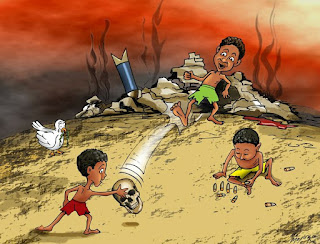There are a few ways of
studies of treatment to complex PTSD, such as clinical treatment. For clinical
treatment, it can follow these steps. At first, remove and protection from the
source of the trauma or abuse. In cognitive therapy, the therapist will helps
you to understand and manage your trauma and its aftermath. You should understand
what make you stress and make your symptoms worse.You will learn to identify
thoughts about the others and
yourself, it is making you feel fear or anxiety.
With the assistance of therapist, you will learn to replace these
thoughts with more accurate and relax thoughts. You will also learn
ways to cope with feelings such as guilt, afraid and conflict.
After a traumatic event, you might blame yourself for things you couldn't have
changed. For example, a girl may feel guilty by wrapped, but
the thing happened lost her control and thinking.
According cognitive
therapy of CBT that helps
you understand that the traumatic event you lived through was not your fault.
Then, separation of residual problems into those that the victim can resolve,
such as personal improvement goals. And those that the victim cannot
resolve,such as the behavior of a disordered family member. During this stage,
the victim maybe experienced a period of recovery time and treatment, her mood
and physical condition have a certain improvement. But there are some problems
still in the deep heart, it takes longer to recover. He can try to adjust his
own feeling, to develop a new plan, such as positive to life, try to make own
feelings peaceful or to avoid irritation. During this time, it also need to fit
behavior of family members, learn how to communication with them and decrease
the family problem. Apparently, victim cannot control others’ behavior and
thinking, so he needs to understand how to get along with family members.
The third way is focus
on to be improved in an
individual's life that is under their own control. The victim who is sensitive,
can not tolerate thing happened by he can not control. It may cause his injury
again and too emotional, can not take care of themselves and so on. So when he
tries to improve his life, it must be based on his own circumstances and can
bear the scope. More, placement in a supportive environment, where the victim can discover they are
not alone. With this stage can
use group therapy, you can join a group which a group of people also have been
through a trauma and complex PTSD. To
talk to someone, maybe you will feel better about your trauma. Group
therapy can detect your symptoms and memories of
trauma, and recover it. It also helps you build new relationships.
You can learn how to
deal with emotions, to build self-confidence and trust. You'll decrease attention of past, to try to
find your own life. As necessary and required,personal therapy to
promote self-discovery, prescription of antidepressant medications.
As we know, sometimes
something happened so suddenly, the victim can not control his emotion, so it
needs the medicine to reduce fear and mad. Generally, the doctor will give the antidepressant
medicine, such as citalopram (Celexa), paroxetine (Paxil), and sertraline
(Zoloft). The chemicals will ease the burden, to effect your
brain. For example, the
victim cannot out of the past experience, always want to kill himself or lost
control. At this time he needs help of doctor. After a period of time to
treatment, the victim should give the feedback to your doctor, then doctor
to according his situation to choose medications treatment for
you.
Reference
Herman, J. (1997). Trauma
and recovery: The aftermath of violence from domestic abuse to political terror.
New York: Basic Books.
Ford, J. D.
(1999). Disorders of extreme stress following war-zone military trauma:
Associated features of Posttraumatic Stress Disorder or comorbid but distinct
syndromes? Journal of Consulting and Clinical Psychology, 67, 3-12.
Van der Kolk, B. (2005).
Developmental trauma disorder. Psychiatric Annals, 35(5), 401-408.
Roth, S., Newman, E.,
Pelcovitz, D., van der Kolk, B., & Mandel, F. S. (1997). Complex PTSD in
victims exposed to sexual and physical abuse: Results from the DSM-IV field
trial for Posttraumatic Stress Disorder. Journal of Traumatic Stress, 10,
539-555.





















